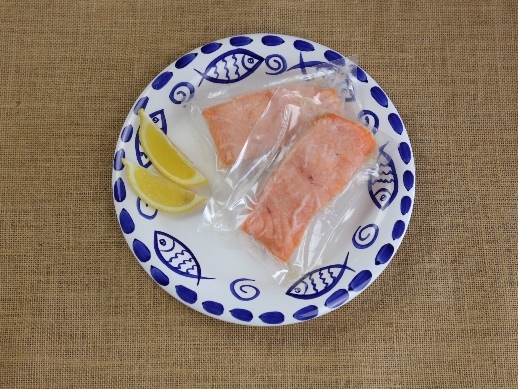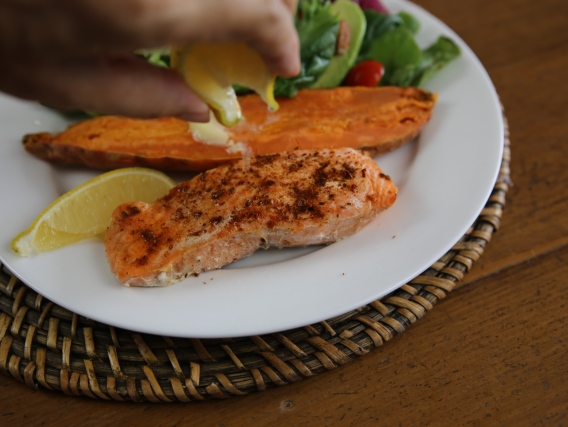Product Snapshot: Tassal Easy-Bake Atlantic salmon fillets
Written by Catherine Saxelby
on Friday, 07 February 2014.
Tagged: convenience, dinner, fish oil, fresh food, healthy cooking, healthy eating, meal planning, omega-3, Product snapshot, protein

Nutritionists recommend two serves of oily fish a week but I find it hard to eat this regularly without resorting to canned salmon or tuna. I love the cans – don’t get me wrong - but they’re not the same as a fish fillet that I can substitute for a steak or chicken portion as a quick working week dinner (You can see how fixated I am on quick everyday dinners!). And you’ve got to take more care with fish than beef or chicken, haven’t you?
1. It’s a hassle making sure my fish is really, really fresh.
Unless you live on the coast near a fish co-op or have access to fresh fish, it can be dodgy buying quality fish. I’m big on the sniff test – the first whiff of anything off and it’s a no-no from me!
2. Not everyone likes to cook fish at home, ranging from being nervous about not over or under cooking it (how do you tell when it’s done?) to disliking the fact that fish can really stink up your whole house - especially if you pan-fry something strong like sardines or mackerel. And how do you avoid those annoying fish bones before they lodge in your throat? A nightmare with kiddies.
3. I worry whether or not I’m buying the non-sustainable varieties which will make me guilty of contributing to the over-fishing of the world’s seas and leaving no fish for future generations. See the Marine Stewardship Council site for a list of the sustainable less-loved fish varieties we should be buying. Or try Good Fish Bad Fish website.
That’s why I am loving the individual frozen salmon fillets by Tassal, an Australian company based in Tasmania, that offers convenient fish that’s perfect for busy working women or anyone living on their own.
Pros
- Convenient – buy and store in your freezer until you’re ready to use it. It has a long shelf life - 12 months - but I’d use it by 3 months just for safety.
- Frozen so it makes oily fish more readily available for people living a long way from the coast.
- Neatly portioned into two individual fillets per box. Each fillet weighs 130 grams so enough for a dinner meal for a woman or small male eater (actually I don’t like a huge serve of salmon – it’s too rich!). Bake one or bake two as you need. Perfect if it’s just you on your own.
- Simply bake plain in its outer plastic wrap – easy and no-mess or fishy cooking smell. Or they can be baked in the oven (which is how I cooked the ones in the picture with Cajun spice) or else in the microwave.
- Sold as natural (plain) which lets you add your own flavourings such as lemon, dill or soy sauce. Or you can buy the flavoured versions e.g. Lemon and Cracked Pepper, Sundried Tomato and Basil, Herb Butter and White Wine, or Teriyaki. They’re pretty good and I don’t generally care for the flavoured versions of things!
- Reasonably priced at around $10 for a pack = which is $41 per kg
- Like all oily fish, it’s high in protein, rich in omega-3 fats and supplies vitamins A and D and minerals such as potassium and iodine.
Cons
- Frozen so not fresh (but bear in mind that around 70 per cent of fish in Australia is frozen).
- Farm-raised on a fish farm, not wild salmon caught in the open waters of Canada or Alaska. However it comes from the clean pristine waters of Tasmania so there’s a good chance of being free of pollutants.
- Yes, not the environmentally ‘perfect choice’ but I’m impressed with how Tassal is looking for better sustainability initiatives and is always improving.
- The jury's out on whether or not this way of raising salmon is acceptable and also there's a question mark over what they're fed i.e. other, smaller fish or grain. It seems to me that each of these options comes with its own issues.
The bottom line
It’s convenient, good for you, reasonable value for money but it could be more environmentally friendly - though at least you’re not eating a fish that’s endangered.
Foodwatch
The Good Stuff
The Boring Stuff
© 2025 Foodwatch Australia. All rights reserved
Website by Joomstore eCommerce







